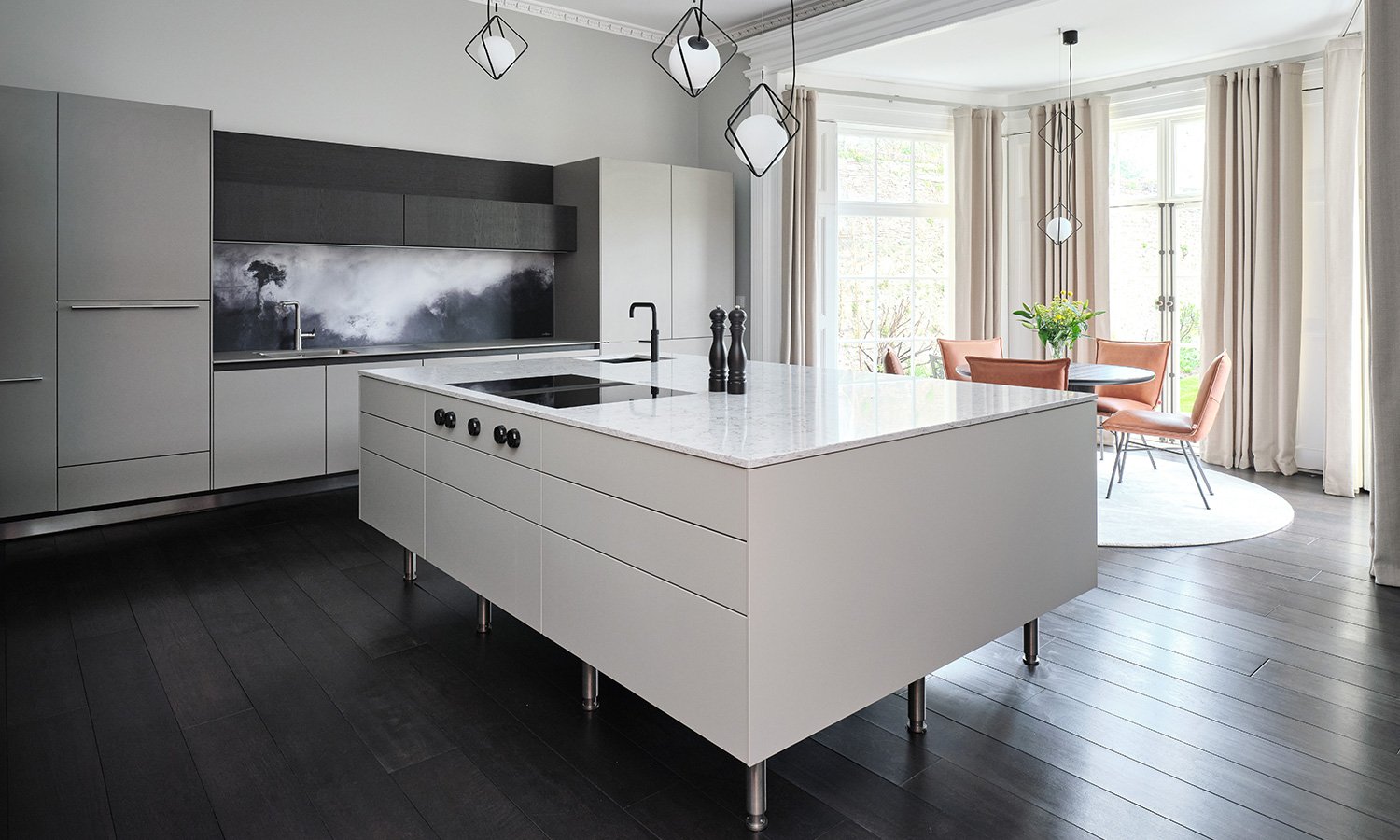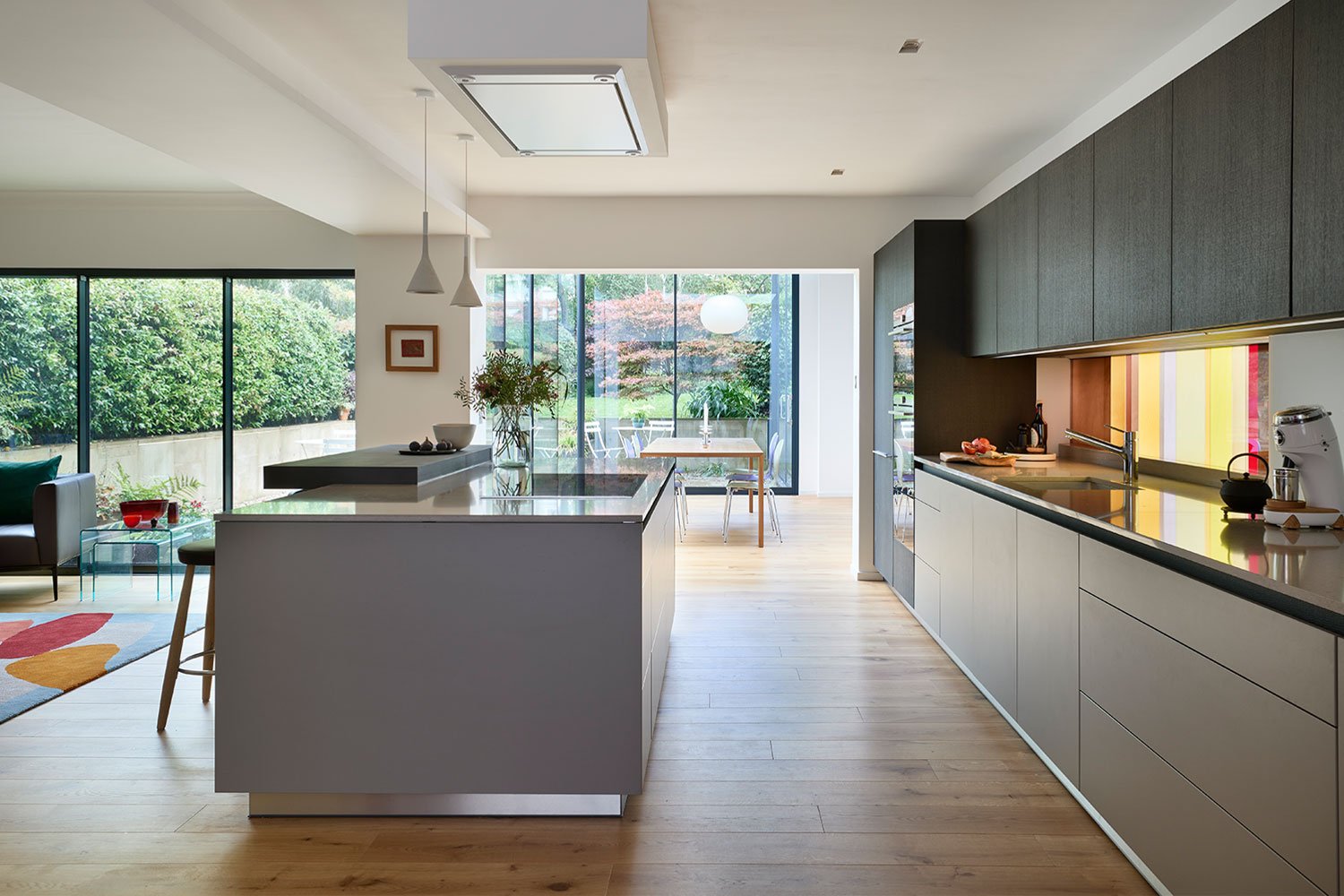What is the Best Floor to put in a Kitchen?
Your new kitchen will require a suitable floor that is going to provide you with the functionality, longevity and style you desire. At Hobson's Choice, our clients often choose between tiles and wood, depending on their personal taste and their lifestyle.
To help you decide about your next kitchen floor, we have summarised the key considerations you should think about to ensure the finished space gives you the look and feel you so desire.
TILES
With a large variety of surface finishes and sizes available, tiles are an attractive option when looking for a hardwearing kitchen floor. They strike a great combination of easy maintenance and durability, particularly if they are made from ceramic or porcelain.
In a kitchen, spills and stains are commonplace, so being able to easily wipe them away quickly makes tiles a very practical choice. Tile grout lines are incredibly moisture resistant, enabling the homeowner to wash and steam clean the floor without fear of damaging the surface. The non-porous surface also prevents allergens or odours from penetrating into the material.
The use of smaller tiles allows for the design of intricate patterns which can add detail and visual interest to the space. Alternatively, large, oversized tiles can create a swathe of uniform colour which allows other areas of the kitchen to become the focus and reduce the amount of grouting required.
COMPARING TILE LAYOUTS
In the bulthaup b3 kitchen with walnut cabinetry (pictured), the use of large tiles reduces our focus on the floor, keeping the viewers’ attention on the visual detail of the solid walnut cabinetry, stone worktops, and interior architecture.
In contrast, the bulthaup b3 kitchen finished in Sand Beige Gold and Kaolin, features wood-effect tiles and a parquet-style layout that adds a natural pattern and warm tones.
This type of tile and arrangement can perfectly balance style and functionality, especially in a kitchen/dining space where the areas overlap.
Occasionally, despite the benefits, tiles are not the preferred option when considering a new kitchen floor.
Cleaning the grout lines can be a chore some people may wish to avoid. Over time the lines can accumulate dirt, especially if the kitchen is linked to an external space and will need attention to ensure they are free of grime.
If the kitchen area in the property is cool due to the structure of the building, having a tiled floor can mean having a cold surface underfoot. Whilst in the summer this may be a welcome experience, in the winter you may not desire such a sensation. This can be improved with the inclusion of underfloor heating.
Tiled floors are incredibly hard and unforgiving when breakables, such as glassware or dishware are dropped, or worse, people slip. If you regularly wipe up spillages or walk-in moisture from outside, consider the risks of a tiled surface. Pets can also be adversely affected due to the reduced grip, especially on polished tile surfaces.
Ceramic and porcelain, by the nature of the material structure, are susceptible to cracks and chips when struck by heavy objects such as pots, pans, or kitchen utensils. Tiles with patterned surfaces, such as a wood effect, can show chips more prominently because the material beneath the surface isn't the same. Surface marks can typically be repaired, or at least visibly reduced in appearance, but cracks would generally require a new tile.
Natural stone floors, granite, marble, or slate, require a greater degree of surface care than porcelain or ceramic equivalents. This is due to the stone being more porous and thus susceptible to spills, moisture and dirt penetrating the surface. Like a hardwood floor, natural stone tiles will require regular sealing, refinishing and cleaning to maintain the appearance and longevity of the floor.
WOOD & ENGINEERED WOOD
The welcoming natural beauty of a wood floor often outweighs the compromises a homeowner will accept when laying a wood floor in their kitchen. It is a more comfortable material to walk upon, feeling warmer to the touch and acts as a natural insulator to the property -- helping to maintain a consistent indoor temperature.
Often, in an open-plan space, the flooring encompasses the entire room, running through areas created for relaxing, dining and cooking. In this situation a wooden floor can link the different zones together, providing a timeless finish that complements any style of kitchen, modern or traditional.
The natural properties of a wooden floor can also make the surface more forgiving to accidental drops of delicate items. It is also less slippery when wet compared to a tiled floor, making it a safer choice for residents.
If sourced sustainably, wood is a renewable resource, making it an environmentally friendly choice. Opting for certified wood helps promote responsible forestry practices. To ensure a wooden floor stands the test of time, modern wood flooring often comes with durable finishes that provide resistance to stains, spills, and wear.
Of course, like everything, there will be situations where a hardwood floor isn’t the ideal recommendation.
Wood is a porous material and is consequently sensitive to moisture. In a kitchen, spills and high humidity are commonplace and excessive exposure can lead to a wooden floor becoming damaged, presenting issues including warping, swelling and staining.
A hardwood and engineered wood floor will also scratch and dent, high-heeled shoes, dropped utensils and pet claws are all capable of leaving marks. A wooden floor can be sanded if it has an oiled finish (the floor is then re-oiled), but if it is pre-finished, varnished for example, then you would need to accept that it will mark over time.
Ongoing maintenance will help to retain the beauty and longevity of a wooden floor, such as regular sealing, refinishing, and careful cleaning. However, colour fading caused by prolonged exposure to sunlight is more difficult to prevent. This is something to think about if your kitchen has large windows.
Other Types of Kitchen Flooring
POURED CONCRETE / RESIN
On the positive side, a poured floor is highly durable and able to withstand heavy foot traffic, dropped items, and the general demands of a busy kitchen. There are also several options to customise the colour of the floor to suit the property decor.
In an open plan space, the seamless look provided by the flooring creates a sleek, industrial style look. The absence of seams reduces the risk of water penetration and makes cleaning relatively straightforward. A quick sweep and a mop are usually sufficient to keep the surface clean.
Like a tiled surface, a concrete floor can be cold, especially in kitchens that lack sunlight. By adding underfloor heating, the feel can be greatly improved.
A poured concrete or resin floor isn't a typical choice for Hobson's Choice clients. In our experience, a poured floor comes with a few caveats that we have learned since the renovation of our Winchester showroom in 2019.
At the time it was an ideal solution to cover the tired stone floor tiles with a finish that would complement our contemporary style and run seamlessly throughout the space. After several years, we have experienced our floor becoming marked to a greater extent than we expected. This has been caused by everyday footfall and the movement of chairs around a dining table.
The installation process is more complex when compared to tiles or wood. Achieving a perfect surface is a task for professionals who understand how to manipulate the wet material and prepare the sub-floor correctly to remove the risk of cracking or an uneven finish.
Anyone who has lived in a new build will likely have experienced fine hairline cracks appearing in plastered surfaces as the plaster dries and the building settles. A similar occurrence is possible in a poured floor, although not a major issue, it may not be to your taste and need repairing.
Once poured, these types of floors are not easily reversible. Changing the flooring, or even accessing services beneath the floor, can be a significant undertaking. Unlike a tile or plank which can be lifted and replaced, a poured floor must be cut out and then repaired. This action can leave a ‘scar’ on the floor which cannot be covered up. To completely remove the floor is a large undertaking.
IN CONCLUSION
For many Hobson's Choice kitchen clients, these flooring types provide the style, durability and appearance they desire for their homes. As part of the kitchen design process, you and your designer will explore a variety of suitable samples that will enhance your kitchen design and work within your property.
This article is designed to get you thinking about what you want from your kitchen flooring and what your priorities are. Everyone's lifestyle is different, and the needs of their kitchens vary, so having a good idea of your preferences is the perfect way to begin a new project.
To start the design process, contact one of our kitchen design team to book an appointment.








